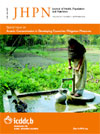
|
The Journal of Health, Population and Nutrition
icddr,b
ISSN: 1606-0997
EISSN: 1606-0997
Vol. 36, No. 1, 2017, pp. 1-8
|
 Bioline Code: hn17021
Bioline Code: hn17021
Full paper language: English
Document type: Research Article
Document available free of charge
|
|
|
The Journal of Health, Population and Nutrition, Vol. 36, No. 1, 2017, pp. 1-8
| en |
Meal frequency and dietary diversity feeding practices among children 6–23 months of age in Wolaita Sodo town, Southern Ethiopia
Mekonnen, Tefera Chane; Workie, Shimelash Bitew; Yimer, Tesfa Mekonen & Mersha, Wubalem Fekadu
Abstract
Background: Child feeding practices are multidimensional, and they change rapidly within short age intervals.
Suboptimal complementary feeding practices contribute to a rapid increase in the prevalence of undernutrition in
children in the age of 6–23 months. Information on child feeding practices among urban resident is limited in
Ethiopia. The aim was to measure minimum meal frequency and dietary diversity and associated factors among
children 6–23 months of age in Wolaita Sodo, Ethiopia.
Methods: A community-based cross-sectional study was carried out to select 623 mothers/caregivers with
6–23 months of children reside in Wolaita Sodo town using systematic sampling from March 02 to 20, 2015.
An interviewer-administered questionnaire was used to gather information on socio-demographic, child feeding
practices and health-related characteristics. Data were entered to Epi-Data version 3.02 and transported to SPSS
version 21 for further analysis. Binary logistic regression was used to see the association between the outcome
variables and explanatory variables, and multivariable logistic regression was performed to identify independent
predictors of minimum dietary diversity and meal frequency.
Results: The study revealed that the percentage of 6–23 months of children who meet the recommended level
of minimum dietary diversity and meal frequency were 27.3 and 68.9%, respectively. Mothers/caregivers who
were housewives and government employees feed their children more diversified foods as compared to mothers
who were private workers. As compared to children 17–23 months of age, children in the age group of 6–8 and
9–11 months had better probability to meet minimum dietary diversity. Government-employed and illiterate
mothers were less likely to feed their children to fulfil the minimum requirement of meal frequency. Children in
the age of 9–11 months were also less likely to be fed frequently.
Conclusions: Even though the study showed better progress as compared to the national prevalence of
complementary feeding practices, child feeding practices in the study area were inadequate and not achieving
WHO infant and young child feeding recommendations. Strengthening the available strategies and creating new
intervention measures to improve socioeconomic status, maternal literacy and occupation opportunity for better
practices of child feedings are compulsory actions for the government and policymakers.
Keywords
Dietary diversity; Meal frequency; 6–23 months of children; Southern Ethiopia
|
| |
© Copyright 2017 - The Author(s)
Alternative site location: http://www.jhpn.net
|
|
